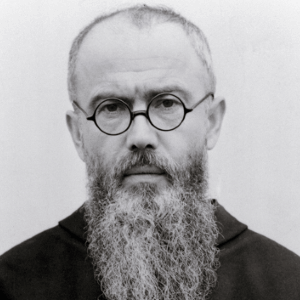
St Maximilian Kolbe was Polish Franciscan friar, martyr, and saint who gave his life for a fellow prisoner in Auschwitz during World War II.
Read the full St Maximilian Kolbe novena on the novena page. You can also learn more about novenas here.
Who Was Saint Maximilian Kolbe?
St Maximilian Kolbe was Polish Franciscan friar, martyr, and saint who gave his life for a fellow prisoner in Auschwitz during World War II. Pray this novena for drug addicts, prisoners, families, and the pro-life movement.
St Maximilian Kolbe was born Raymund Kolbe in Poland on January 8th, 1894.
Poland at this time was part of the Russian Empire. His father was a weaver and mother was a midwife.
At age 12, Kolbe was given a vision of Our Lady. He wrote of this:
That night I asked the Mother of God what was to become of me. Then she came to me holding two crowns, one white, the other red. She asked me if I was willing to accept either of these crowns. The white one meant that I should persevere in purity and the red that I should become a martyr. I said that I would accept them both.
Shortly thereafter in 1907, Kolbe entered the minor seminary with the Conventual Franciscans.
Three years later he became a Novice, where he was given his religious name Maximilian.
He professed temporary vows in 1911 and final vows in 1914, also taking on a second religious name, Mary.
During his time of temporary vows, he traveled to Rome to attend the Pontifical Gregorian University, earning a doctorate in philosophy.
In 1915, he attended the Pontifical University of St Bonaventure, earning a doctorate in theology.
While studying, Kolbe and several friends formed the Militia Immaculata, encouraging people to consecrate themselves totally to Mary.
The Freemasons were making violent protests against the Pope in Rome, which Kolbe witnessed, describing their actions thusly:
They placed the black standard of the Giordano Brunisti [Bruno] under the windows of the Vatican. On this standard the archangel, St. Michael, was depicted lying under the feet of the triumphant Lucifer. At the same time, countless pamphlets were distributed to the people in which the Holy Father (i.e., the Pope) was attacked shamefully.
In response, Kolbe directed the Militia Immaculata to ask Our Lady especially for the conversion of enemies of the Catholic Church, specifically the Freemasons.
Kolbe even amended the Miraculous Medal prayer to include this intention:
O Mary, conceived without sin, pray for us who have recourse to thee. And for all those who do not have recourse to thee; especially the Freemasons and all those recommended to thee.
Kolbe was ordained to the priesthood in 1918.
He returned to Poland the next year and continued encouraging consecration to Our Lady, while countering the leftist communist movement.
As a priest, he taught at the seminary in Krakow but contracted tuberculosis, then an incurable disease, but he was able to endure with it.
In 1922, Kolbe began writing a monthly periodical, the Knight of the Immaculata, a devotional publication and years later at his new Franciscan monastery began printing it and other Catholic writings.
In 1930, Kolbe traveled to China and then Japan, founding a Franciscan monastery in the latter near Nagasaki.
He translated his Knight of the Immaculata into Japanese to evangelize.
Shortly thereafter he visited Malabar, India and founded a new monastery as well.
He returned to Poland at various times, and when World War II erupted, Kolbe remained in the monastery there.
He was arrested on September 19th, 1939 when the Germans captured his town but was released in December.
He hid thousands of Jews in his friary and began publishing anti-Nazi tracts.
In February of 1941, the Germans closed the monastery and the Gestapo arrested Kolbe.
On May 28th, he was sent to Auschwitz.
Through beatings and persecution, Kolbe persisted in acting as a priest.
In July, a prisoner escaped from Auschwitz, and the Nazis responded by choosing ten men to be starved to death in a bunker as punishment.
Franciszek Gajowniczek was one of the men chosen. He begged to be spared for the sake of his wife and children.
Maximilian Kolbe heroically volunteered to take his place.
Each day, Kolbe prayed and encouraged the other prisoners.
The Nazis starved them and gave them no water for weeks, and all but Kolbe had perished.
Frustrated, they injected Kolbe with carbolic acid.
He died on August 14th, 1941.
He was beatified on October 17th, 1971 by Pope Paul VI, and canonized October 10th, 1982 by Pope John Paul II.
He is the patron saint of the pro-life movement, political prisoners, amateur-radio operators, drug addicts, and families.
His feast day is August 14th.